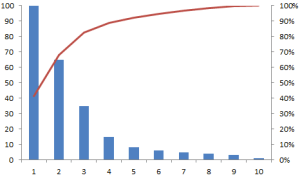Everybody has heard of the 20-80 rule. Also known as the Pareto principle (which is a statistical cumulative distribution, but don’t let that bother you). What were the basics again, and what is interesting to know about it?

Say you have 10 products (x-axis), yielding turnover in dollars (y-axis, left). If you calculate the percentage of the total turnover per product, and you add that up, you’ll get the red line (related to y-axis, right). Here, product 1 (which is 10% of the number of products) makes 41% of total turnover. Add product 2, good for 27% of turnover, and now you can see that the best 20% of your products make 68% of turnover. The other 80% of your products are good for only 1/3rd of the total turnover.
This difference between things having or less impact is só normal, that this makes the 20-80 rule. Meaning: 20% of the amount of something makes 80% of some result. It doesn’t have to be about products and turnover. The same rule can show that only 20% of the people in a country make 80% of all the income (i.e. few people are very rich, most are not). This in insightful in itself, but what else is interesting about the 20-80 rule? Here are 5 pieces.
1. It helps prioritize non-exact decisions.
The 20-80 rule does not depend on exact numbers. You can use it as a rule of thumb, to make distinctions about what is more or less important in relation to something. This can help you prioritize. The rule for instance has its place in time management, where it says: always focus on the 20% of activities that have 80% impact on the task/result you are working on. The same goes for working on your happiness (20% of your occupations generate 80% of your happiness), or on your business (in terms of e.g. focus on clients or products).
2. It can help clean up your life.
You can apply it in the same way to negative things: 80% of your worries and frustrations come from 20% of all things that entail negativity. Address or quit those 20% (e.g. overly critical clients that bring lots of negative attention, or troublesome dominant relationships).
3. The less successful part can still be worthwhile.
The smaller result of the 80% does not mean that this is not worthwhile. Applied to business, this “long tail” of the curve could still mean a big market. And that is good news: you don’t necessarily need monster hits and blockbusters to make enough money. In fact: most businesses are here: serving either local, or niche, or otherwise less visible, but still viable markets.
4. The less successful part may be critical to success.
Applied to a product portfolio, having the less successful majority might be critical to success. It may be tempting to focus on the successful 20% and to discard the rest, but it could be that clients precisely value that you have such a large offering (supermarkets also tend to be less attractive when their offering gets thinner).
5. This 20-80 is not 100.
Lastly, probably the most fun fact. The fact that 20-80 adds up to 100 is a symbolic choice, falsely suggesting that the relation between the two makes 100%. The two elements (amounts of the one, results of the other) are in reality rarely related in that way, and the two numbers will usually be smaller or larger than 100. It could for instance be that 3% of your offering makes 80% of the results (making it 3-80 instead of 20-80). Or that 1 of your 3 products (33%) makes 90% of profit (making it 33-90). In other words: against the suggestion of the name of “the 20-80 rule”, the numbers were never meant to be added up.
Go for SpeedMBA Online now: the business e-course in which you get ALL OF BUSINESS explained in 300 slides and 60 videos!
